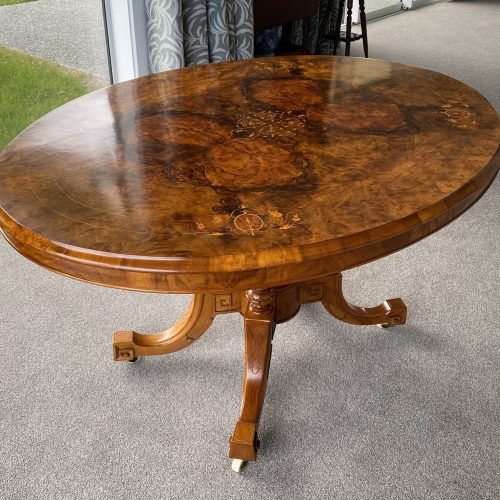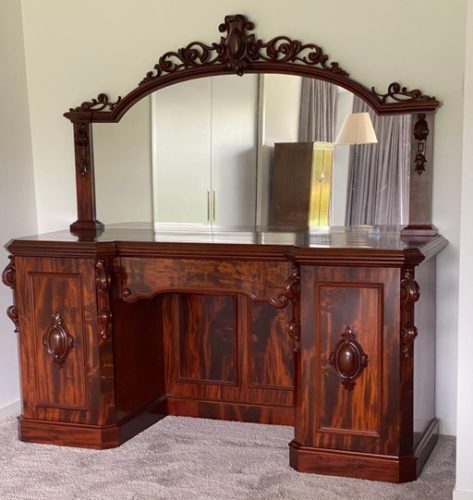

You’ve probably read or heard of us raving on about French polishing at some point over the years. But what exactly is this mysterious furniture restoration practice that takes years and years to master? If your wooden furniture looks a bit lacklustre, dull or damaged, French polishing could answer your restoration prayers.
At Kilmister Furniture Restoration, we’ve been using this classic technique for over 40 years. Tony was trained by French polisher Brian Kilmister. You could say that we’ve built up a knack for this classic restoration technique over this time. In this guide, we’ll explore a brief history of French polish in NZ, why French polishing is still popular today, and other key benefits.

As mentioned, French polishing has been a popular furniture restoration and furniture repair method for many years. How old? Well, French polishing dates back to the 15th century. That’s almost older than Tony! Yes, French polishing was first used between the years 1401 and 1500. However, this wood furniture restoration technique didn’t really pick up in popularity until later in the 18th century. Back then, Victorians that were more wealthy would pay a master French polisher to make their pricy furniture look fantastic and more durable.
Fast forward to today, and businesses like us here at Kilmister Furniture Restoration still carry out this method to this day. And, the technique is still very similar to how it was carried out back in the day. For more information about the techniques we use, read our guide on the difference between furniture restoration and furniture refinishing.
Fun fact: Over the years, shellac has also been used on electrical appliances and machinery. This is because shellac is great at keeping our moisture and insulating.
If French polishing yields such a fantastic end result, why doesn’t everyone do it in their garage at home? Well, as you’d probably imagine, there’s a real art to French polishing. As well as that, the process takes a long time with a lot of room for error. But, if you ask us, the laborious process is totally worth it if you know what you’re doing. The end product will look much better when you leave French polishing up to a professional.
The process is relatively similar, whether regarding an antique furniture restoration or French polishing something modern. French polishing is essentially applying many very thin layers of a substance called shellac. This shellac is applied in most cases with a specialised polish mop or a fad. The fad is usually covered in soft cotton for smooth distribution.
The time-consuming thing about French polishing is that you need to wait for each layer of shellac to dry before applying the next layer. These layers will continue to be applied until you get the desired that famous, rich-coloured wood and glossy finish.


As mentioned, when restoring antique furniture with a French polish technique. This polish is unlike other more modern substances. Shellac is completely natural and comes from the lac beetle. When this beetle makes its cocoon, it creates this fantastic and durable resin for furniture restoration and repair.
When mixed with alcohol, this shellac gives an unrivalled finish. Shellac is also used for nail polish in some cases. This is because shellac nails last a long time and are seen as a non-chipping option. As well as that, shellac nails are also often seen as shinier than gel alternatives.

Whether a boardroom table and chairs or your favourite wooden cabinet repair, French polishing is a fantastic option to bring your favourite furniture back to life. For both modern and antique furniture restoration, there are many reasons to opt for this technique.
Especially in today’s day and age with tablets and laptops, wooden furniture can easily get scratched, chipped or damaged. Just think of the last time you threw your keys onto the table when you got home! Thankfully, a shellac French polish finish is durable. Although it may not be as durable as some modern polishes or varnishes, it’s still water and scratch-resistant. Shellac is also flexible. This means it’s less likely to crack if wood expands in the heat.

At Kilmister Furniture Restoration, we’re big on helping the environment and keeping old furniture out of the landfill. One way to be more sustainable is to always opt for furniture repair instead of buying new. Another way is to choose French polishing as your preferred antique furniture restoration method.
As we’ve covered, shellac is completely natural and, therefore, non-toxic. This also means that the technique is safe for pets and young children, unlike some modern techniques and chemicals.
Accidents happen. It doesn’t matter how careful you are with your favourite credenza or coffee table; sometimes, you cause scratches and damage. Luckily, French polish is cost-effective to touch up. Just give us a bell at Kilmister Furniture Restoration.

If you put a piece of furniture that’s been French polished up against a modern piece of furniture that’s only had a cheap varnish, it’ll be like comparing chalk and cheese. In terms of creating a high-shine and stunning natural wood finish, French polish is unrivalled.
This technique is famous for showcasing wood’s rich colours and natural beauty. I guess that’s why this technique has been so popular for over 500 years. No matter how you mix and match your existing decor, you’re French-polished piece will look amazing.


No one likes doing housework. Thankfully, furniture is easy to clean and maintain if it has been French polished. You won’t need to bust out expensive and toxic sprays. Instead, all you need to do to clean is clean it with a light application of neopol once in a while. You can buy this for a few bucks at your local supermarket. Be sure only to use a light amount.
Using abrasive cleaning supplies and rough clothes can create scratches in your wood finish that adds up over time. Usually, when cleaning antique wood furniture, you want to take a less is more approach.
French polishing is a great technique for nearly all wood furniture restoration. Both modern pieces for a luxurious look and antique furniture repair, French polishing will bring your furniture back to life. Cabinets, tables, chairs, and musical instruments like stunning grand pianos can all benefit. As well as that, some classic homes also use French polish for their stairs or even floor.
Top tip: If you’ve recently restored a boardroom table and want maintenance advice, read our guide on how to care for your boardroom table and chairs.
Any wood can be suitable for French polishing. In saying that, historically, French polish in NZ has been preferred for close grains and hard or darker-toned woods. Any wood is good for this technique. However, really popular woods include:
There are different shades of shellac that can be used for French polishing. So, if you’re considering this technique as an option, talk to us at Kilmister Furniture Restoration, and we’re happy to offer free advice. For further insight into whether your furniture is worth the investment to begin with, read our guide on how to know whether to replace or repair furniture.

As you’d expect, there’s not one blanket cost to furniture restoration or furniture repair, let alone French polishing. In saying that, french polishing with us here at Kilmister Furniture Restoration is cost-effective. And, considering how long your furniture will have a stunning finish, we think it’s well worth the investment.
French polishing should always be left to an expert. Otherwise, you could end up clouding and causing more damage than good. Instead of that classic mirror look and beautiful deep wood finish, you could end up with a mess.
These days French polishers are hard to come by, especially ones with as much experience as us. We’re happy to offer a free quote on your potential French polishing or general furniture restoration. Simply send us a photo of your furniture or call us, and we’ll get back to you with a cost breakdown as soon as possible.

French polishing is an antique furniture restoration technique that’s been used since the 15th century. There are so many reasons why this classic technique has stood the test of time. And, we’re proud to still carry on this art form every day in our workshop.
If you’d like to see some examples of our work, including French polished furniture, head over to our Kilmister Furniture Restoration Facebook page. We keep this page up to date with regular before and after pictures of our work. If you have any questions about French polishing, furniture repair or general furniture restoration, be sure to get in touch. Feel free to contact us on our website where you can easily fill out a form and attach photos, message our Facebook page or call us on 0272301203.
We use cookies to improve your experience and measure ad performance.
This includes secure tracking with Google Ads Enhanced Conversions. By using our website, you agree to this.
You can read our privacy policy here or click the button to continue to our website.